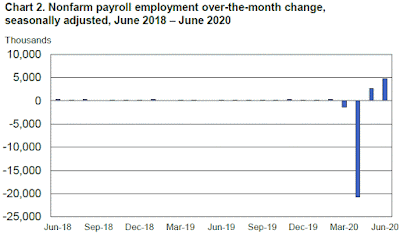Employment Situation Report for June 2020
The Employment Situation Report for June 2020 was released by The Department of Labor's Bureau of Labor Statistics this morning:
Nonfarm Payrolls (month-to-month change)
Predicted: +3,500,000
Actual: +4,800,000
U-3 Unemployment Rate (Headline)
Actual: 11.1%
Previous Month: 13.3%
12 Months Previous: 3.7%
U-6 Unemployment Rate*
Actual: 18.0%
Previous Month: 21.2%
12 Months Previous: 7.2%
Average Hourly Earnings (month-to-month change)
Predicted: -0.5%
Actual: -1.178% (-$0.35)
Average Hourly Earnings (year-on-year change)
Predicted: +5.0%
Actual: +5.043% (+$1.41)
Average Weekly Earnings (month-to-month change)
Actual: -1.746% (-$18.01)
Average Weekly Earnings (year-on-year change)
Actual: +5.349% (+$51.45)
Civilian Labor Force Participation Rate: 61.5%
Previous Month: 60.8%
12 Months Previous: 63.0%
Average Workweek
Predicted: 34.5 hours
Actual: 34.5 hours
Economist, academics, central bankers and investors pay very close attention to the monthly Employment Situation report as it offers penetrating insight as to the current and near-future state of the overall U.S. economy. If a) Americans are earning more money and b) the economy is creating new jobs, this typically translates to more money being pumped into the economy (and vice versa.)
The "predicted" figure is what economists were expecting, while the "actual" is the true or real figure.
===================
From Today's Report:
===================
===================
* = The U-6 Unemployment Rate is defined as:
===================
===================
Nonfarm Payrolls (month-to-month change)
Predicted: +3,500,000
Actual: +4,800,000
U-3 Unemployment Rate (Headline)
Actual: 11.1%
Previous Month: 13.3%
12 Months Previous: 3.7%
U-6 Unemployment Rate*
Actual: 18.0%
Previous Month: 21.2%
12 Months Previous: 7.2%
Average Hourly Earnings (month-to-month change)
Predicted: -0.5%
Actual: -1.178% (-$0.35)
Average Hourly Earnings (year-on-year change)
Predicted: +5.0%
Actual: +5.043% (+$1.41)
Average Weekly Earnings (month-to-month change)
Actual: -1.746% (-$18.01)
Average Weekly Earnings (year-on-year change)
Actual: +5.349% (+$51.45)
Civilian Labor Force Participation Rate: 61.5%
Previous Month: 60.8%
12 Months Previous: 63.0%
Average Workweek
Predicted: 34.5 hours
Actual: 34.5 hours
Economist, academics, central bankers and investors pay very close attention to the monthly Employment Situation report as it offers penetrating insight as to the current and near-future state of the overall U.S. economy. If a) Americans are earning more money and b) the economy is creating new jobs, this typically translates to more money being pumped into the economy (and vice versa.)
The "predicted" figure is what economists were expecting, while the "actual" is the true or real figure.
===================
From Today's Report:
"...The change in total nonfarm payroll employment for April was revised down by 100,000, from -20.7 million to -20.8 million, and the change for May was revised up by 190,000, from +2.5 million to +2.7 million. With these revisions, employment in April and May combined was 90,000 higher than previously reported..."
"...Coronavirus (COVID-19) Impact on June 2020 Establishment and Household Survey Data
Data collection for both surveys was affected by the coronavirus (COVID-19) pandemic. In the establishment survey, approximately one-fifth of the data is assigned to four regional data collection centers. Although these centers were closed, interviewers at these centers worked remotely to collect data by telephone. Additionally, BLS encouraged businesses to report electronically. The collection rate for the establishment survey in June was 63 percent, lower than collection rates prior to the pandemic. The household survey is generally collected through in-person and telephone interviews, but personal interviews were not conducted for the safety of interviewers and respondents. The household survey response rate, at 65 percent, was about 18 percentage points lower than in months prior to the pandemic..."
===================
===================
===================
* = The U-6 Unemployment Rate is defined as:
"Total unemployed, plus all persons marginally attached to the labor force, plus total employed part time for economic reasons, as a percent of the civilian labor force plus all persons marginally attached to the labor force."
===================
===================
Labels: Coronavirus, COVID-19, COVID19, employment, employment_situation, hard_data, jobs, labor, new_economy, wages
|
--> www.FedPrimeRate.com Privacy Policy <--
CLICK HERE to JUMP to the TOP of THIS PAGE > SITEMAP < |





0 Comments:
Post a Comment
<< Home